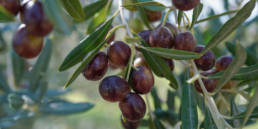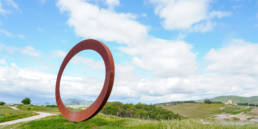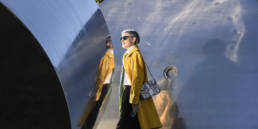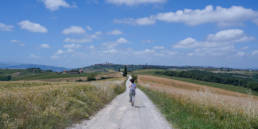We drove up a little road just off the main drag of Sant’Albino, a town between Chianciano Terme and Montepulciano, and arrived at Poggio Etrusco, the B&B and home of cookbook writer Pamela Sheldon Johns, where we were greeted by a large dog, a happy guest, and Pamela herself. I had received a review copy of her book Cucina Povera some weeks before, and felt that I had to meet this woman who has written a cookbook you could actually just read, without going into the kitchen. What is her trick? How does she approach her research? How long must it have taken to put together this genre-crossing book?

Like anyone with a good sense of hospitality, Pamela first offered us cappuccino (made by her artist husband Johnny, and approved by my Italian husband Tommaso) and an olive oil cake made by a particularly talented student at the day before’s cooking class, and we got to talking about many things that were not cookbooks. As with any two expats who meet, one goes over “how we got here.” Pamela moved with her husband and daughter (now 14) when the latter was nearing school age and her many research trips to Italy seemed less practical than just settling down here.

In this big open kitchen made for conviviality, she showed me some of her books. For a woman who has written over a dozen books and runs one of Food & Wine’s top ten culinary workshops in Italy, she’s extremely modest and down to earth. As I flipped through Pamela’s books i found that some aspects that had struck me about Cucina Povera turn out to be present in her earlier books too, especially Italian Food Artisans, though this latest is a real masterpiece.
“Cucina Povera: Tuscan Peasant Cooking” – translated literally as “poor food” – has a printed hard cover, rough edged heavy pages, and warm photography. If you judge a book by its cover, this one’s already a winner. And when I got it, I wondered how I, far from a foodie, would review a cookbook beyond its cover. Yeah, I can cook and bake (I’ve even posted a few recipes on this blog – see Tommaso’s grandma’s crostata for example). But I am not one who can evaluate if one ribollita is more authentic than the next. No problem here; I have been saved by the bell book.
Cucina Povera is a book to have, to read and to look at, even if you have no idea how to make soffritto or skin hazelnuts (the book tells you how to, anyway). It’s not a reference book to use to look up recipes – though you could do that – but rather one that merits a proper read before shelving it in the kitchen or displaying it on the coffee table. The 40-page introduction could be expanded into a whole book, in my opinion, and it’s primarily about this part that I asked Pamela during my visit.
As we sat at the large table that Pamela uses for cooking classes, I asked her my first hard, critical question. Cucina Povera, I said, is this a manifesto? Why should we be eating this way, now? It didn’t seem to me that the book stated that all essential “why”, and as a good scholar I was taught that every essay or book had to do so. “It’s not a manifesto.” responds Pamela. Her own interest in thrifty cooking came from her mother’s Depression-era habits; here in Italy she found a kindred approach in many peoples’ kitchens. Many Tuscan dishes, it turns out, come from humble ingredients and embody a concept of re-use and saving.

Rather than a manifesto that says we should all eat this way – which I’d suggest would be pretty impractical for your average American, or for anyone who doesn’t have time to cook a soup for three days – the book is a preservation of an important phase in Italian culinary history that will be lost with the passing of the elder generation. Pamela traveled to every part of Tuscany to gather these tales. You get the sense that she probably ate her way through a lot of country kitchens in the process, so it may not have been terribly arduous.
Jokes aside, Pamela sat down with some of the oldest people in Tuscany, the real preservers of tradition, the best cooks in the land, and asked them what they ate in hard times. It’s not a question you can casually pop to anyone who survived Nazi occupation. She drew out a lot of hard stories; almost every person in front of her was in tears at some point. Writing the book, she had to make some difficult choices about length and content, knowing that the cookbook genre requires recipes after a short introduction, but her heart was so involved in telling these peoples’ stories.

These grandmas and grandpas generously share their recipes, which have been adapted to American measurements and ingredients when necessary. Each dish is beautifully photographed, displayed in an impressive array of appropriately rustic tableware and settings. Some recipes show the versions cooked by the interviewees. My favourite photos are those of the old people themselves. They’re in typical Tuscan settings and photographed with wonderful natural light. Although photographer Andrea Wyner was not with Pamela during the whole process of her research, you get the impression that they traveled together for a year, for both people and food are captured in such a natural way.

There’s no doubt that Pamela’s a good talker and a good listener. We quickly wiled away hours and I started to understand how she got all these stories out of people. What’s her modus operandi? “Taxi drivers and bars,” she says. A small town barman might direct her to a patron, to his mother, to someone who will introduce her to the right person to get the story. It takes time and patience. With all this time spent talking, our stomachs are quite ready for lunch.
Lunch in Monticchiello
We went to Enoteca La Porta in nearby Monticchiello, where owner Daria is a somellier and friend; Pamela often takes groups here for a wine tasting experience. I had the most generously dressed tagliatelle al tartufo ever, while Pamela and Tommaso enjoyed the steak “tagliata” with shaved raw porcini mushrooms on top and perfectly matched wine by the glass.


The weather was changing that day so we ate inside, missing out on the restaurant’s gorgeous terrace. When the rain stopped after lunch we explored the very cute town and I took a few photos (see the flickr gallery below).

Book giveaway
The publisher has generously offered a copy of this book to give away to one lucky, hungry reader.
How to win? Just comment on this blog post. Sure, I’d appreciate it if you’d like my facebook page and share this blog with your friends, but I can’t force you.
What should you write? Anything. Tell me why you want this book, tell us your best money saving kitchen tip, recount your best tuscan eating or cooking experience, say what recipe you hope to find in this book, or what you’ve learned from Pamela in the past.
A few rules. Comments close at midnight european time on Halloween, October 31 2011. Contest open worldwide. You must register your comment with a valid email address and respond to the winning notification within 48 hours. Winner will be chosen by random draw.
Hey if you don’t win you can always buy the book here!
Sign up to receive future blog posts by email
Alexandra Korey
Alexandra Korey aka @arttrav on social media, is a Florence-based writer and digital consultant. Her blog, ArtTrav has been online since 2004.
Related Posts
November 17, 2021
My favourite suppliers of Tuscan olive oil
May 20, 2021
Volterra: Art, Wine and Minerals
January 17, 2021




